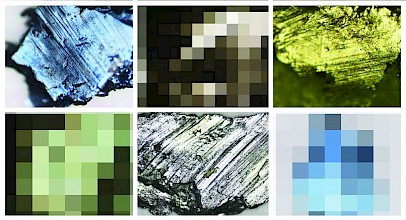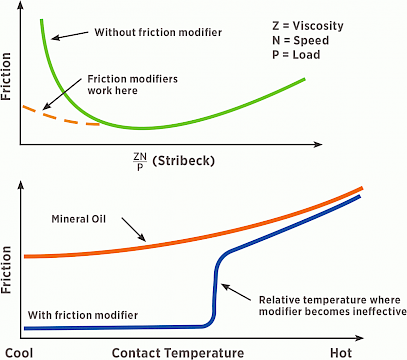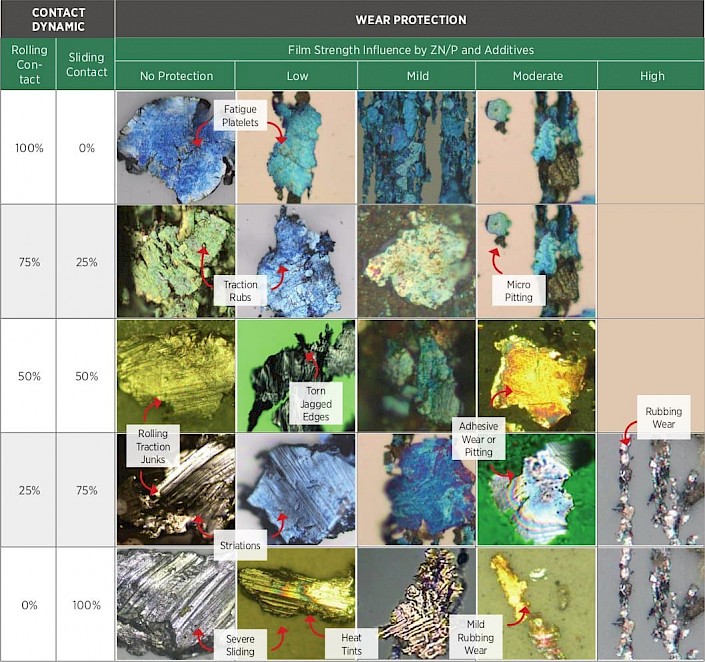Deciphering Important Visual Features of Wear Particles
When working from a single sample, it is common for labs to classify wear particles according to standardized shapes such as platelets, chunks, ribbons and spheres. The task of deriving meaning from the number and size of particles in the different classifications is much more difficult. Condition monitoring is not about science - it’s about understanding and reporting what is happening, why it’s happening, where it’s happening and how severe or threatening the condition might be. This can be a daunting task, to say the least.
 The lubricant co-exists with the machine and has an active presence in its critical frictional zones. As such, the progression of wear-related machine failures does not go unnoticed by the lubricant. The byproducts of wear and surface damage become suspended in the lubricant, embedded in the filter or stratified as sediment in nooks and crannies.
The lubricant co-exists with the machine and has an active presence in its critical frictional zones. As such, the progression of wear-related machine failures does not go unnoticed by the lubricant. The byproducts of wear and surface damage become suspended in the lubricant, embedded in the filter or stratified as sediment in nooks and crannies.
As failure advances, most wear modes produce more particles, and some also produce larger particles. In certain cases, what was thought to be an advanced failure state may suddenly appear benign or in decline. There are reasons for this, so do not be fooled. The wounds and excavations from wear do not heal over on their own.
The time has come to increase the specificity of wear particle characterization. The four basic shapes were a good start, but there is much more we can learn and apply. For those who understand vibration, imagine being limited to vibration overalls or only what is produced in the low-frequency velocity spectrum. Likewise, thermal imaging has shown us how to look far beyond discrete temperature values or trends. This analogy applies to wear debris analysis as well. The appearance of particles holds many clues that generally go unnoticed or are just not understood.
The Characterization of Particles (ASTM D7684)
Any good tribologist will tell you that real failure modes rarely conform to strict theoretical models - rather, they are more complex and are usually the combination of many contributing factors and conditions. There are exceptions - for instance, it is easy to recognize the shapes from cutting wear and normal rubbing wear - but that’s basically where the simplicity comes to an end.
Understanding chunks and platelets require closer examination and greater skill. Factoring in size, colour, heat tinting, slide orientation, texture and count, plus an array of other features in the same debris field, is the tribologist’s task. Yet, we don’t really have many formally trained tribologists in condition monitoring.
The recently published standard ASTM D7684, Microscopic Characterization of Particles from In-Service Lubricants, went far to add greater granularity and guidance, as shown in the examples below from its classification grid:
- Colour and texture: pitted, striated, smeared, tempered, colours from transmitted and reflected light
- Shapes: platelet, ribbons, chunks, spheres, etc.
- Composition: ferrous, cupric, sludge, dust, etc.
- Wear modes: abrasion, mild sliding, severe sliding, rolling contact (subsurface spall)
- Two-dimensional aspect ratio (minimum to maximum) and particle size distribution
Even with the help of D7684, many lab analysts fail to connect the dots between wear debris characterization and the needed maintenance response. Often, connecting the dots requires the aid of careful machine inspection and findings from other condition monitoring methods (vibe, etc.).
Introducing the WPCD Table
The discussion that follows offers some valuable tips on how to get more condition monitoring value from wear particle analysis and identification. A high percentage of wear particles found in in-service lubricating oils are produced from pure sliding contact (abrasion and adhesion), rolling contact (Hertzian) or various mixtures of the two. Therefore, this article will focus specifically on particle generation mechanisms from machine surfaces in various states of rolling and sliding contact.
To streamline the discussion, I’m not going to include the following types of particles, which will be addressed at a later time:
- Laminar particles. Reworked by over-rolling.
- Cutting wear particles. Usually, the result of hard particles interposed between sliding surfaces.
- Spherical particles. A complex and still generally misunderstood subject.
- Break-in particles. An artefact of running in new machines (gears primarily).
- Soft particles. Also known as varnish potential.
- Terrain dust. This is a huge topic - the cause of wear but not the product of wear.
| Zone | Rolling Contact | Sliding Contact | Example Locations |
|---|---|---|---|
| A | 100% | 0% | Rolling cam follower, roller bearing (load zone), spur gear pitch line |
| B | 75% | 25% | Rolling-element bearings, most gear-mesh contacts (root to tip), hydraulic pumps (rotating), screw compressors, some mechanical couplings |
| C | 50% | 50% | |
| D | 25% | 75% | |
| E | 0% | 100% | Sliding cam follower, pump swash plate, bearing cage, piston/cylinder, worm gearing, journal bearings, chains |
Table 1 shows five Contact Dynamics Zones. The top zone is 100% rolling contact, and the bottom is 100% sliding contact. The three middle zones are binary mixtures of the two. I have added examples of where they might be found in common machines.

These zones also appear on the Wear Particle Contact Dynamic (WPCD) table in Table 2. The five columns across the top of the WPCD table are the Wear Protection States, ranging from no protection to high protection. Based on the well-known Stribeck Curve (AKA the ZN/P curve), these states are directly influenced by oil viscosity, surface speed, contact load and additive film strength. For rolling contacts (e.g., ball bearings), specific film thickness (Lambda) is also influenced by composite surface roughness. Refer to the chart in Figure 1 and the article in the link below for more information on the Stribeck curve: https://www.machinerylubrication.com/Read/27725/
Rooted in Tribology
Very little of what happens between surfaces in relative motion should be viewed as simple or even predictable; this holds true for the formation of particles generated there. With this in mind, the 25 cells shown in the WPCD Table are coded with letters corresponding to likely wear modes - these are approximations based on experience and findings from controlled laboratory experiments. Let's get more specific about each of these likely wear modes.
Normal Rubbing Wear. These particles result from mild and slightly adhesive cyclic rubbing contact. They are often described as traction-induced exfoliation or peeling of the shear-mixed layer (asperities). Small abrasive particles interposed between frictional surfaces can increase the concentration of rubbing wear. Most appear as thin flakes or platelets with polished surfaces on both faces; others may be somewhat more granular from rolling-sliding contact.
Adhesive Wear. Caused by moderate to high traction forces from impaired lubrication or high contact loads in sliding frictional zones. The wear modes are more pronounced where longer sliding planes/tracks exist (e.g., large gear teeth). High tangential forces and frictional heat transfer loosened metal from one surface to the other or released it into the oil as dislocated fragments. Particles have smooth, distressed or striated surfaces; striation is generally from two-body abrasion. Many exhibit the appearance of a momentary molten state (micro-welding).

Pitting (Micro & Macro). These particles can be formed due to rubbing or adhesive contact, as well as rolling contact fatigue. Micropitting occurs where particles - usually less than 20 microns in size - dislodge. Macropitting is similar to micropitting, except the size of the pits and particles are larger than 20 microns, often as a result of an advanced state of micropitting.
Rolling Contact Fatigue. These are often due to contact (surface) fatigue aided by mild sliding contact (traction). Particles may appear peeled from delamination. Many have smooth surfaces (face side) with irregular edges. They may appear thin and platelet-shaped - similar to laminar particles but without a flattened over-rolled appearance.
Rolling Traction Fatigue. This results from a combination of rolling and sliding under elasto-hydrodynamic lubrication (EHL) conditions. Cyclic Hertzian loads radiate downward, which propagates crack formation and subsurface fatigue from repeated flexing. Combined sliding produces traction forces, dislocating particles from the socket of the bruised area. Subsequent rolling contact produces downward flaking at the edges, causing the damaged area to spall out further.
Premature fatigue often occurs due to the over-rolling of hard contaminant particles (e.g., silica), which induces surface indentations and berms (stress risers). These are initiation sites for cracking, flaking and spall-out conditions.
Chunk-like particles from rolling traction fatigue typically exhibit fractured or torn surfaces and edges. Some may show a less chunky appearance, such as a thick platelet with varying shapes and profiles.
Fatigue particles generated by a ball bearing may resemble a rose petal shape. Torn or feathered edges are common. They are frequently subjected to over-rolling (rework), which alters appearance, producing a more laminar shape.
| Contact Dynamic | Wear Protection | |||||
|---|---|---|---|---|---|---|
| Rolling Contact | Sliding Contact | Film Strength Influence by ZN/P and Additives | ||||
| None | Low | Mild | Moderate | High | ||
| 100% | 0% | K-K | K | F-F | B,D,F | A |
| 75% | 25% | E,H | D,E | C,D | B,D | A |
| 50% | 50% | H-H | E,H | C-C,D,G | B-B | A |
| 25% | 75% | H,J,L | H,I | E,G | C,D | B |
| 0% | 100% | J-J,L | J,L | I | C | B |
B. Normal rubbing wear
B-B = Normal to moderate rubbing
C. Mild Adhesive Wear
C-C = Moderate
D. Micropitting
F. Fatigue platelets
F-F = Severe platelets
G. Mild rolling traction fatigue
H. Severe rolling traction fatigue
H-H = Extremely severe
J. Severe sliding/adhesive wear
J-J = Extremely severe
K. Severe rolling contact fatigue
K-K = Extremely severe
L. Black Iron Oxides
Table 2 The Wear Particle Contact Dynamics (WPCD) Table. The letters under the Wear Protection columns are described in the legend at the bottom of the table.
The particle’s face may have striations or the appearance of adhesion (micro welding). Heat-tinting from friction/adhesion may exhibit colours from straw to brown to blue.
Sliding Wear (Abrasion/Adhesion). Often occurs in high slide-to-roll or slide-only frictional zones. Boundary lubrication conditions from highly-loaded, low-speed conditions where only anti-scuff/AW additives play a role in mitigating friction and wear. More pronounced from longer sliding planes/tracks (e.g., large gear teeth), high traction forces due to boundary conditions and sliding serve to lift and dislodge fragments producing surface spalls. In gearing, the condition may be more pronounced across the dedendum zone of the gear tooth flank (below pitch line towards the root).
Large particles with long straight edges and rectangular shapes are common. Otherwise, particles may have highly irregular shapes, and their edges may appear sharp or jagged. The base surface (opposite particle face) will appear torn or fractured.
Evidence of abrasion, scoring or adhesion on the particle face is common. Deep striations may crisscross, travel the length of the particle (in the direction of elongation) or converge to the central region. Heat-tinting from friction may leave colours from straw to brown to blue.
Black Oxides. Black iron oxides are typically clusters of small pebble-like particles. Dark-metallo oxides may be larger, possessing the shape and size of rolling traction fatigue or adhesive wear particles. Most will have free metalcore with an oxide shell. Particles are very dark or black in appearance but may have small blue and orange dots near the lower limit of an optical microscope. Edges will transmit some light. Black oxides are associated with poor lubrication and steel-on-steel contact.
Table 3 This version of the WPCD Table replaces the cell wear mode designations with example particle images.
Particle Size and Count
The WCPD Table in Table 3 has been re-casted to show images of example particles corresponding to the cells’ failure modes. Note, there is no reference (or scale) related to particle size. The purpose of the table is to emphasize and distinguish characteristic visual features of particle shape and texture. These features provide important clues related to wear modes and wear location.
It is widely known that particle size generally correlates to failure stage or severity. For instance, particles on the left side of the table are distinctly larger (>50 microns) than those on the right side of the table (<15 microns). Large particles are even more pronounced in the cells in the upper-left zone of the table. Fatigue particles frequently produce larger particles (at advanced wear stages) than those produced from two-body abrasion, scuffing and adhesive wear.
The population of wear particles at different sizes and shapes is important too and can help estimate the particle generation rate related to the precipitous state of the failure. However, particle concentrations are influenced by other factors too, including:
- Where and how samples are taken
- Fluid turbulence and sedimentation
- Filtration (micron size and capture efficiency)
- Age of the oil
Because of this added complexity, it is often better to view the particle size distribution in terms of rate-of-change and size ratios (or per cent large particles). If both increase significantly, the machine could be approaching an end-of-life condition.
Work Backwards
The best approach is to use the ASTM D7684 Classification Grid and the WPCD Table together. A careful examination of particle size, shape, edge detail and texture reveals much about contact dynamics and surface protection (position on the Stribeck curve). From there, you can work backwards to better understand and report condition monitoring information and prescriptive response:
- What is happening: wear modes
- Where it’s happening: slide/roll features, composition, etc.
- Why it’s happening: location on the Stribeck Curve
- Severity: remaining useful life related to particle size, shape and concentration
Include relevant facts and data from inspection and other condition monitoring tests.
The potential for deciphering the hidden messages in wear particles depends heavily on training and practice. Over time, wear debris analysis can and should become a far more powerful early-detection condition monitoring tool.

